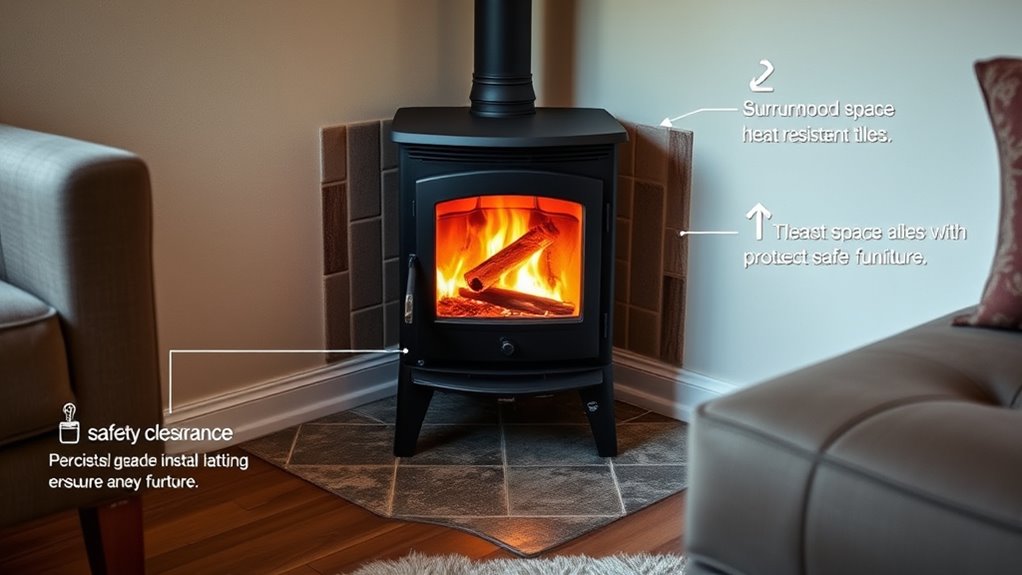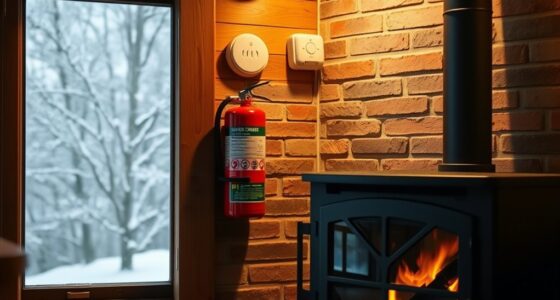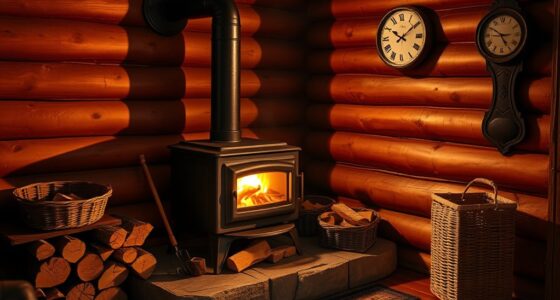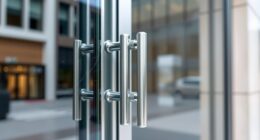To guarantee safety and efficiency, follow your wood stove manufacturer’s clearance guidelines, typically maintaining at least 36 inches from combustible materials. Install proper ventilation and use heat shields or fire-resistant barriers as recommended. Keep flammable items well away, and regular maintenance helps prevent hazards. Proper spacing and placement not only meet safety rules but also improve performance. Keep exploring for detailed tips on installation and maintaining safe clearances for your stove.
Key Takeaways
- Maintain a minimum of 36 inches clearance from combustible materials, following manufacturer and local code guidelines.
- Ensure proper chimney height and heat shield placement as specified by the stove manufacturer for safety and efficiency.
- Use fire-resistant barriers or shields around the stove to reduce heat transfer to nearby combustible surfaces.
- Verify clearances for venting and heat shields before installation, and keep flammable items at recommended safe distances.
- Regularly inspect and maintain the stove, chimney, and safety barriers to ensure ongoing compliance with safety rules.
Understanding Manufacturer Clearance Specifications
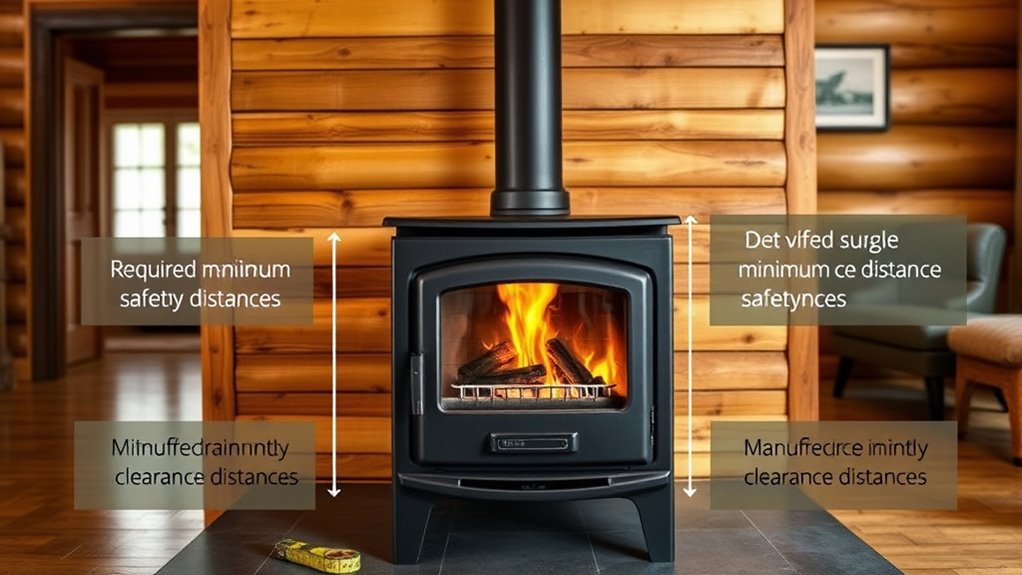
Understanding manufacturer clearance specifications is essential to safely installing your wood stove. These guidelines include critical details like chimney height and heat shield placement, which ensure proper venting and fire safety. A proper chimney height promotes effective draft, preventing smoke backflow and creosote buildup. The chimney height affects draft and proper smoke exit, so adhere to the recommended measurements to prevent smoke backflow or creosote buildup. Heat shield placement is equally important; it helps protect combustible surfaces from excessive heat. Many manufacturers specify the exact distance a heat shield should be installed from the stove or wall to maintain safe clearances. Ignoring these specifications can compromise safety and reduce stove efficiency. Proper installation practices are vital to ensure safety and optimal stove function. Always review your stove’s installation manual thoroughly, paying close attention to the clearance requirements related to chimney height and heat shield placement. Additionally, understanding clearance specifications helps prevent potential hazards and promotes optimal stove performance. Following manufacturer guidelines ensures you meet all safety standards and enhances the longevity of your stove. Proper adherence to these guidelines is crucial for ensuring fire safety and efficient operation of your wood stove.
Standard Safety Distances for Wood Stoves

Maintaining proper safety distances around your wood stove is crucial to prevent fires and guarantee safe operation. Typically, you should keep at least 36 inches of clearance from combustible materials, but check your stove’s manufacturer guidelines for exact distances. To enhance safety, consider installing fireproof barriers or shields, especially in tight spaces. Applying heat resistant paints on nearby non-combustible surfaces can help reduce heat transfer and minimize fire risks. These barriers and coatings act as extra protection, ensuring that heat doesn’t reach combustible objects. Always verify local building codes and manufacturer instructions before setting your clearances. Additionally, understanding the types of cookies used on related safety and installation websites can help you manage your online privacy while researching safety guidelines. Proper spacing, adherence to safety standards, and protective measures create a safer environment, reducing the chance of accidental fires and ensuring your stove operates efficiently. Incorporating advanced filtration technology can also improve indoor air quality, providing additional health benefits when operating your stove safely. Regular inspections and heat transfer management are essential to maintain a safe and efficient stove setup. Furthermore, being aware of Gold IRA considerations such as fees, scams, and proper custodial procedures can teach you the importance of thorough research and compliance when making investments.
Proper Placement of Combustible Materials
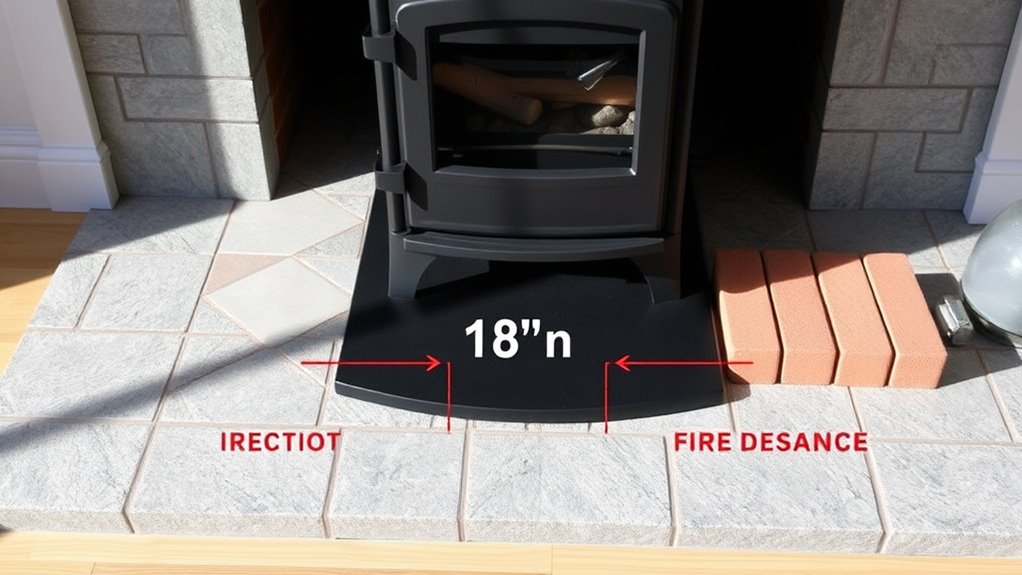
To guarantee safety when using your wood stove, you must carefully consider how you place combustible materials nearby. Keep flammable items like paper, fabrics, and furniture at safe distances, adhering to recommended clearance guidelines. Using fire resistant barriers can provide an extra layer of protection, especially when space is limited. These barriers help contain heat and prevent accidental ignition. Install combustible wall protection behind and around the stove to shield walls from heat and sparks. Ensure all combustible materials are kept at least the minimum clearance distances specified by your stove’s manufacturer. Proper placement of these materials reduces the risk of fires and ensures your setup remains safe during operation. Regularly inspecting your setup and understanding fire safety best practices can further enhance your home’s safety. Additionally, understanding projector technology can help you select safer, more efficient setups for your space. For example, choosing models with automatic shut-off features can prevent overheating and accidents. Incorporating space organization techniques can help you maintain clear areas around your stove, reducing clutter and potential hazards. Always follow safety recommendations to protect your home and loved ones.
Ventilation and Clearance Considerations
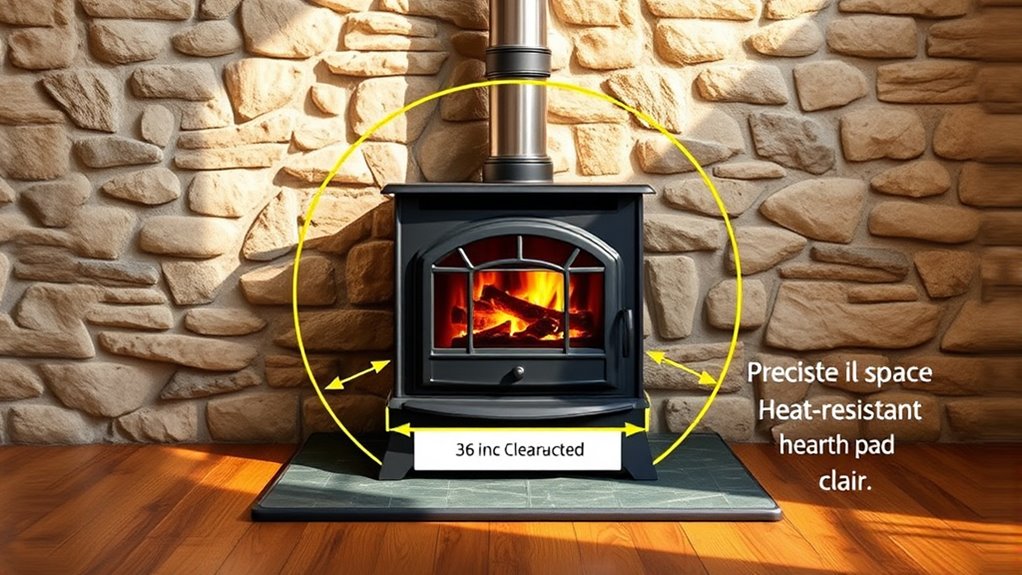
Proper ventilation is essential for safe and efficient wood stove operation, as it guarantees adequate airflow and prevents dangerous buildup of carbon monoxide. A well-designed chimney plays a crucial role in venting smoke and gases effectively, ensuring proper draft and reducing the risk of smoke spillage. When considering clearance, heat shielding is vital to protect nearby combustible materials from excessive heat transfer. Proper chimney design minimizes heat transfer to surrounding walls, allowing for closer clearances without risking fire hazards. Ensure that your stove’s clearance guidelines account for ventilation pathways and heat shielding requirements. Enhanced airflow not only improves safety but also boosts stove efficiency, reducing creosote buildup and maintaining optimal airflow. Additionally, understanding sound healing science can inspire innovative approaches to creating a calm and safe environment around your stove area. Incorporating ventilation strategies with proper clearance practices can further optimize safety and performance. Ensuring that your setup adheres to fire safety regulations is crucial for preventing accidents and ensuring compliance. Always follow manufacturer instructions and local codes to ensure your ventilation and clearance setup is safe and effective. Moreover, considering air quality improvements can contribute to a healthier indoor environment.
Tips for Safe Installation and Maintenance
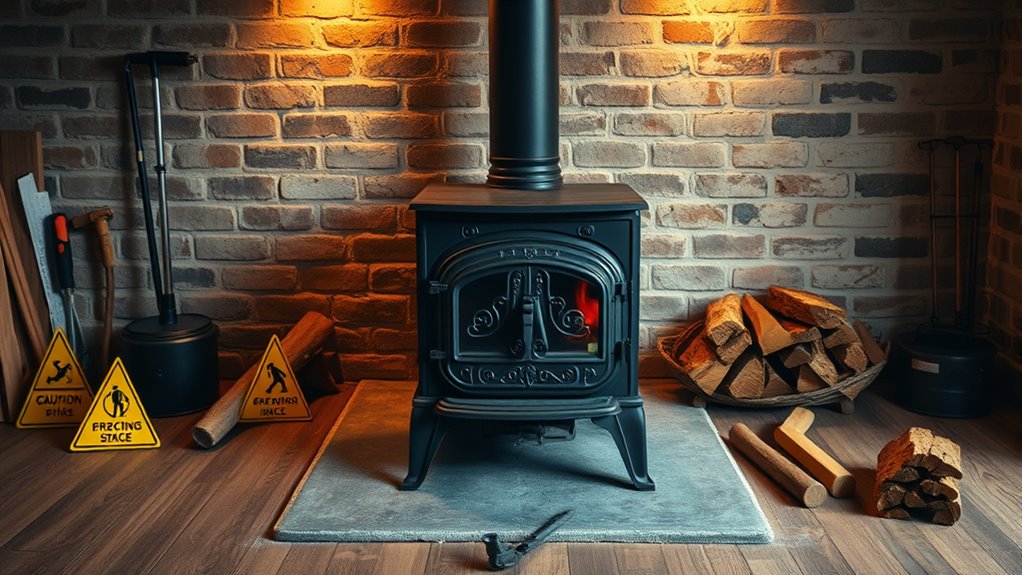
Make certain your wood stove is installed correctly by carefully following the manufacturer’s instructions and local building codes. Proper installation ensures ideal chimney draft, which improves heat transfer and reduces creosote buildup. To maintain safety and efficiency, consider these tips:
- Regularly inspect and clean the chimney to prevent blockages that can affect draft and cause smoke backflow.
- Check clearances and ensure proper heat transfer away from combustible surfaces, maintaining safe distances.
- Schedule professional maintenance annually to verify that all components work correctly and to address any potential hazards.
- Selecting a location with good scenic views and outdoor seating can enhance your overall experience and safety during use.
- Ensuring proper installation spacing according to guidelines helps prevent fire hazards and improves stove performance.
- Be aware of fire safety regulations and have appropriate fire extinguishing equipment on hand to respond quickly to emergencies.
- Proper ventilation and airflow are crucial components of a safe and efficient wood stove setup.
- Additionally, understanding clearance guidelines can significantly reduce the risk of accidents and ensure compliance with safety standards.
Frequently Asked Questions
How Do I Measure Clearance Distances Accurately?
To measure clearance distances accurately, start by gathering a measuring tape and wearing safety gloves for protection. Extend the tape from the edge of the stove to the nearest wall or object, ensuring it stays straight and taut. Double-check your measurements to avoid errors, and mark the spots if needed. Precise measurements help you follow safety rules, preventing fire hazards and ensuring proper spacing for safe installation.
Can Clearance Requirements Vary by Stove Model?
You might find that clearance requirements can vary slightly depending on your stove model, making it essential to verify the manufacturer’s specifications. During stove maintenance and venting procedures, adhering to these specific guidelines ensures safety and efficiency. Always consult your stove’s manual, as some models may need more space for proper operation. This small step helps prevent hazards and keeps your stove running smoothly and safely.
What Are the Consequences of Insufficient Clearance?
If you don’t maintain proper clearance around your stove, you risk serious consequences. Insufficient clearance can create a fire hazard by allowing heat to reach combustible materials. It also leads to ventilation issues, trapping smoke and dangerous gases inside your space. These problems increase the chance of fires, carbon monoxide buildup, and health risks. Always follow clearance guidelines to keep your home safe and guarantee your stove operates efficiently.
Are There Specific Tools Recommended for Installation?
When installing a wood stove, you should use fire-resistant tools like gloves and mats to prevent accidents. Installation gauges are essential for measuring proper clearance distances, ensuring safe placement. Having these tools on hand helps you maintain safety standards and avoid potential hazards. Always follow manufacturer instructions and local codes, and double-check measurements with gauges before final installation to keep everyone safe and your home protected.
How Often Should I Check Clearance and Safety Measures?
Did you know that improper clearance is a leading cause of home fires? You should check your clearance and safety measures monthly to guarantee ventilation requirements are met and that fire-resistant materials remain intact. Regular inspections help prevent overheating and fire hazards, especially as your stove and surroundings age. Staying vigilant means your home stays safe, and you enjoy cozy warmth without risking safety.
Conclusion
Ensuring proper clearance around your wood stove is key to safe, efficient heating. Following manufacturer guidelines and safety distances reduces fire risks and improves airflow. Did you know that improper clearance can increase fire hazards by up to 80%? By carefully placing your stove and maintaining clearances, you’ll enjoy warm, cozy comfort without worry. Stay vigilant with regular maintenance and always prioritize safety to keep your home secure and inviting.

